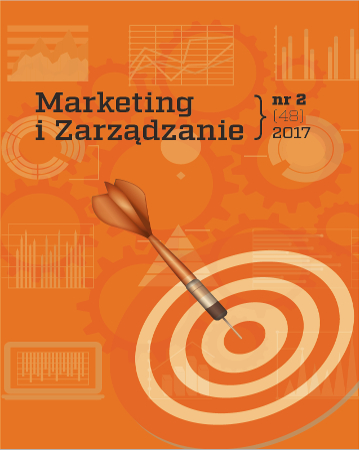
ISSN: 2450-775X
eISSN: 2353-2874
OAI
DOI: 10.18276/miz.2017.48-17


Issue archive /
nr 2 (48) 2017
Food dangerous for the consumer in INFOSAN events
| Authors: |
Marcin
Pigłowski
Akademia Morska w Gdyni, Wydział Przedsiębiorczości i Towaroznawstwa |
| Keywords: | FAO WHO food safety cluster analysis |
| Data publikacji całości: | 2017 |
| Page range: | 8 (189-196) |
| Klasyfikacja JEL: | C38 F53 L66 Q18 |
Abstract
The goal of the study was to analyze the dependences between food type and year, involvement type and hazard type (adopted as variables) within events of INFOSAN (International Food Safety Authorities Network). The study covered 209 events included in the annual reports for 2011–2015. Cluster analysis and scatterplots were used. Most frequently the following food types were notified: meat and meat products (in 2014), fish and other seafood (2015) and also vegetables and vegetable products, nuts and oilseeds, fruit and fruit products (2011) and milk and dairy products (2012 and 2013). In these products there were usually stated biological hazards and the INFOSAN was directly and significantly involved in events (within coordination). The similar types of dangerous food products notified in the INFOSAN and the European RASFF (Rapid Alert System for Food and Feed) and American RFR (Reportable Food Registry) can point out the possibility of closer cooperation within these systems. The international food flow requires the appropriate conditions in supply chain. Therefore, the attention of consumers should be paid to food from national, regional and local markets.
Download file
Article file
Bibliography
| 1. | Cortiñas Abrahantes, J., Bollaerts, K., Aerts, M., Ogunsanya, V., Van der Stede, Y. (2009). Salmonella serosurveillance: Different statistical methods to categorise pig herds based on serological data. Preventive Veterinary Medicine, 89 (1–2), 59–66. DOI: 10.1016/j.prevetmed.2009.01.009. |
| 2. | Ding, X., Bai, S., Zhang, K., Wang, L., Wu, C., Chen, D., Jia, G., Bai, J. (2012). Tissue Deposition and Residue Depletion in Broiler Exposed to Melamine-Contaminated Diets. Journal of Integrative Agriculture, 11 (1), 109–115. |
| 3. | FAO, WHO (2016). INFOSAN activity report 2014/2015. Geneva: FAO, WHO. |
| 4. | Fischnaller, M., Bakry, R., Bonn, G.K. (2016). A simple method for the enrichment of bisphenols using boron nitride. Food Chemistry, 194, 49–155. DOI: 10.1016/j.foodchem.2015.07.117. |
| 5. | Fisher, I.S.T. (2011). Surveillance for foodborne pathogens in humans. In: S. Brul, P.M. Fratamico, T.A. McMeekin (eds), Tracing Pathogens in the Food Chain (p. 11–29). Cambridge: Woodhead Publishing. |
| 6. | Huang, Y.Q., Wong, C.K.C., Zheng, J.S., Bouwman, H., Barra, R., Wahlström, B., Neretin, L., Wong, M.H. (2012). Bisphenol A (BPA) in China: A review of sources, environmental levels, and potential human health impacts. Environment International, 42, 91–99. DOI: 10.1016/j.envint.2011.04.010. |
| 7. | Kleter, G.A., Marvin, H.J.P. (2009). Indicators of emerging hazards and risks to food safety. Food and Chemical Toxicology, 47 (5), 1022–1039. DOI: 10.1016/j.fct.2008.07.028. |
| 8. | Liu, B., Zhang, L., Zhu X., Shi, Ch., Chen, J., Liu, W., He, X., Shi, X. (2011). PCR identification of Salmonella serogroups based on specific targets obtained by comparative genomics. International Journal of Food Microbiology, 144 (3), 511–518. DOI: 10.1016/j.ijfoodmicro.2010.11.010. |
| 9. | Marvin, H.J.P., Kleter, G.A., Frewer, L.J., Cope, S., Wentholt, M.T.A., Rowe, G. (2009). A working procedure for identifying emerging food safety issues at an early stage: Implications for European and international risk management practices. Food Control, 20 (4), 345–356. DOI: 10.1016/j.foodcont.2008.07.024. |
| 10. | Marvin, H.J.P., Kleter, G.A., Prandini, A., Dekkers, S., Bolton, D.J. (2009). Early identification systems for emerging foodborne hazards. Food and Chemical Toxicology, 47 (5), 915–926. DOI: 10.1016/j.fct.2007.12.021. |
| 11. | Polder, A., Gabrielsen, G.W., Odland, J.Ø., Savinova, T.N., Tkachev, A., Løken, K.B., Skaare, J.U. (2008). Spatial and temporal changes of chlorinated pesticides, PCBs, dioxins (PCDDs/PCDFs) and brominated flame retardants in human breast milk from Northern Russia. Science of The Total Environment, 391 (1), 41–54. DOI: 10.1016/j.scitotenv.2007.10.045. |
| 12. | Soon, J.M., Singh, H., Baines, R. (2011). Foodborne diseases in Malaysia: A review. Food Control, 22 (6), 823–830. DOI: 10.1016/j.foodcont.2010.12.011. |
| 13. | Stein, C., Ellis, A., Jones, T. (2011). Detection, investigation and control of outbreaks of foodborne disease. In: S. Brul, P.M. Fratamico, T.A. McMeekin (eds), Tracing Pathogens in the Food Chain (p. 47–88). Cambridge: Woodhead Publishing. |
| 14. | Tauxe, R.V., Doyle, M.P., Kuchenmüller, T., Schlundt, J., Stein, C.E. (2010). Evolving public health approaches to the global challenge of foodborne infections. International Journal of Food Microbiology, 139, S16–S28. DOI: 10.1016/j.ijfoodmicro.2009.10.014. |
| 15. | Tirado, M.C., Clarke, R., Jaykus, L.A., McQuatters-Gollop, A., Frank, J.M. (2010). Climate change and food safety: A review. Food Research International, 43 (7), 1745–1765. DOI: 10.1016/j.foodres.2010.07.003. |
| 16. | Tlustos, C., Anderson, W., Evans, R. (2013). Responding to food contamination incidents: principles and examples from cases involving dioxins. In: M. Rose, A. Fernandes (eds), Persistent Organic Pollutants and Toxic Metals in Foods (p. 110128). Cambridge: Woodhead Publishing. |
| 17. | WHO, FAO (2013). INFOSAN activity report 2011–2012. Geneva: WHO, FAO. |
| 18. | WHO, FAO (2014). INFOSAN activity report 2013. Geneva: WHO, FAO. |